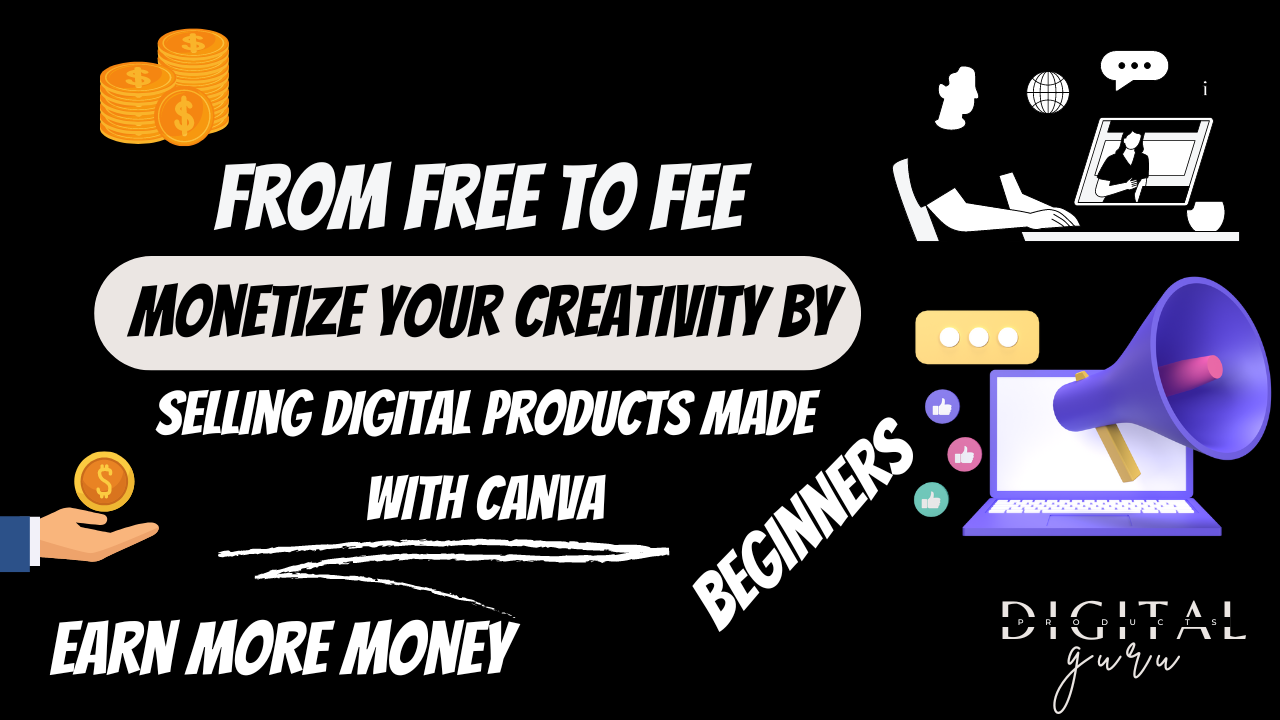Let’s dive into the exciting world of monetizing your creativity by selling digital products made with Canva. Whether you’re a seasoned designer or just starting out, Canva provides a user-friendly platform to showcase your talent and turn it into income. In this step-by-step guide, we’ll explore how you can leverage Canva to create and sell digital products, all while adding a human touch to your entrepreneurial journey.
Table of Contents
1. Identify Your Audience and Product Ideas
Before you start designing, understand your target audience. What are their needs, interests, and pain points? Consider niches like social media templates, printable artwork, e-books, or digital planners. Combining your passion with market demand is key.
2. Sign Up for Canva

- Navigate to Canva’s Website:
- Open your web browser and visit the Canva website.
- You’ll be greeted by a world of creative possibilities!
- Click the “Sign Up” Button:
- Look for the “Sign up” button located at the top right corner of the page.
- Click on it to begin the account creation process.
- Enter Your Email Address:
- If you choose email sign-up, enter the email address you’d like to use for your Canva account.
- Click “Continue.”
- Choose an Account Name:
- Create a unique account name that represents you or your brand.
- This name will be associated with your Canva profile.
- Verify Your Email Address:
- Canva will send a confirmation code to the email address you provided.
- Check your inbox and enter the code to complete the sign-up process.
- You can set a password later in your account settings.
- Welcome to Canva! 🎉
- You’re all set! You can now log in anytime using the email address you’ve set.
- Forgot your password? No worries—you can reset it anytime.
3. Explore Canva’s Design Tools and Templates

- Templates for Every Occasion:
- Canva offers thousands of beautiful free templates for various purposes. Whether you’re designing social media posts, business cards, resumes, or even book covers, there’s a template waiting for you.
- Human Touch: Imagine browsing through a treasure trove of possibilities. Each template represents an opportunity to express your unique style and connect with your audience.
- Customization Made Easy: Drag and Drop Magic 🪄:
- Canva’s drag-and-drop feature allows you to customize templates effortlessly. No complex design skills required!
- Human Touch: Picture yourself rearranging elements like a digital puzzle. Move that text box, resize the image, and adjust colors—all with a few clicks. It’s like arranging a bouquet of creativity.
- Categories Galore: From Resumes to Instagram Stories:
- Explore templates across various categories:
- Social Graphics: Craft eye-catching Instagram posts, stories, and Facebook covers.
- Printables: Design brochures, posters, and invitations.
- Business Essentials: Create business cards, letterheads, and invoices.
- Web Banners: Make your website pop with stunning banners.
- And So Much More!
- Human Touch: Think of these categories as rooms in a creative mansion. Each door opens to a different adventure—whether it’s promoting your brand or celebrating a special occasion.
- Explore templates across various categories:
- Free Canva vs. Canva Pro:
- Canva Free: Basic tools for solo or collaborative design. Access templates, media, and the easy-to-use editor.
- Canva Pro: Unlock additional features like premium templates, advanced design tools, and team collaboration.
- Human Touch: It’s like choosing between a cozy studio and a bustling art studio. Both have their charm; pick what suits your creative journey.
- Millions of Media Elements:
- Canva boasts a vast library of images, graphics, and videos. From serene landscapes to quirky icons, it’s all there.
- Human Touch: Imagine browsing through an art gallery where every frame tells a story. These media elements are your brushes, waiting for your strokes of imagination.
- Your Personal Canva Adventure:
- Sign up, explore, and let your creativity flow. Whether you’re a seasoned designer or a curious beginner, Canva welcomes you.
4. Create Your Digital Product

Let’s embark on the creative journey of creating your digital product with a human touch. Imagine sitting across from me in a cozy coffee shop, sipping your favorite brew, as we dive into the process together:
1. Define Your Vision: The Heartbeat of Your Product
- Imagine Your Ideal Customer: Close your eyes and envision the person who will benefit from your digital product. What challenges do they face? What dreams do they hold? This person is your muse—the heartbeat of your creation.
- Choose Your Product Type:
- E-Book: Perhaps you’re passionate about a specific topic—say, healthy recipes or productivity hacks. An e-book allows you to share your knowledge in a structured format.
- Printable Artwork: If you’re an artist at heart, consider creating printable posters, wall art, or inspirational quotes. People love to decorate their spaces with beauty and meaning.
- Digital Planner: Organizational enthusiasts crave well-designed planners. Think daily, weekly, or monthly layouts. Add sections for goal-setting, habit tracking, and reflection.
- Social Media Templates: Entrepreneurs, influencers, and bloggers need eye-catching graphics for their online presence. Design templates for Instagram, Pinterest, or Facebook.
- Online Course Materials: If you’re an expert in a field, create course materials—slides, worksheets, and handouts—for aspiring learners.
2. Gather Your Tools: The Artist’s Palette
- Canva: Our trusty canvas! Open your Canva account (if you haven’t already) and explore its features. Remember, Canva is like a magical toolbox filled with fonts, colors, shapes, and images.
- Research and Inspiration: Browse the internet, visit Pinterest boards, and flip through magazines. Collect inspiration like seashells on a beach. What colors resonate with your vision? Which fonts evoke the right emotions?
3. Sketch Your Blueprint: Pencil Meets Paper
- Storyboard Your Product: Grab a notebook or open a digital document. Sketch out the structure of your product. How many pages or screens will it have? What content goes where?
- Wireframe Your Design: Imagine you’re an architect designing a cozy cottage. Create wireframes—simple outlines—of each page or section. Where does the title go? How about the call-to-action buttons?
4. Design with Intention: The Brushstrokes
- Typography: Fonts are like personalities. Choose wisely. Serif fonts for elegance, sans-serif for modernity, and script fonts for whimsy. Ensure readability—no squinting allowed!
- Color Palette: Colors evoke emotions. Blue for calmness, red for passion, green for growth. Create a harmonious palette. Imagine your product as a bouquet of flowers—each color playing its part.
- Images and Graphics: Select visuals that resonate with your message. A serene beach scene for a relaxation e-book, or vibrant icons for a productivity planner. Remember, every image tells a story.
5. Customize and Personalize
1. Tailor Your Typography: The Art of Expression
- Font Selection: Fonts have personalities. Choose one that resonates with your product’s vibe. Here are some options:
- Serif Fonts: Elegant and timeless. Perfect for e-books or formal documents.
- Sans-Serif Fonts: Modern and clean. Great for digital planners and social media templates.
- Script Fonts: Playful and whimsical. Use them sparingly for headings or quotes.
- Font Sizes and Hierarchy: Imagine you’re arranging a bookshelf. The title should be prominent (like a hardcover), while body text can be smaller (like a paperback). Create a visual hierarchy.
2. Color Harmony: Painting with Emotions
- Color Psychology: Colors evoke feelings. Let’s choose a palette:
- Calm Blues: Tranquility, trust, and reliability.
- Energetic Reds: Passion, excitement, and urgency.
- Fresh Greens: Growth, balance, and harmony.
- Neutral Grays: Sophistication and balance.
- Consistency: Imagine your product as a cozy room. Ensure that colors flow seamlessly from page to page. Consistency is like matching curtains and cushions.
3. Imagery with Purpose: A Picture’s Worth
- Hero Images: Imagine your product’s cover as a storefront window. What image will entice passersby? A serene landscape, a vibrant abstract, or a minimalist icon?
- Relevance: Every image should serve a purpose. If you’re creating a recipe e-book, show mouthwatering food. If it’s a social media template, feature eye-catching visuals related to the theme.
4. Personal Notes and Quotes: Heartfelt Additions
- Author’s Note: Imagine you’re writing a heartfelt letter to your readers. Include an introduction—why you created this product, your passion, and your hopes for them.
- Inspirational Quotes: Sprinkle quotes throughout. Imagine leaving little love notes in unexpected places. These can uplift, motivate, or make someone smile.
5. Testimonials and User Stories: Real Connections
- Fictional Testimonials: Imagine your product has fans. Create fictional testimonials. What would “Sarah” say about your e-book? How did “Alex” benefit from your planner?
- User Stories: Imagine you’re at a cozy gathering, sharing success stories. Craft mini narratives. “Meet Emily, who transformed her social media game using our templates.”
6. Interactive Elements: Inviting Engagement
- Editable Fields: If possible, allow users to personalize their digital product. Imagine a planner where they can input their goals or a template where they can change text and colors.
- Clickable Links: Imagine your product as a map. Add signposts—hyperlinks—to guide users. Whether it’s linking to related content or your social media, make it easy to explore.
6. Set Up Your Online Store
1. Choose Your E-Commerce Platform
- Research and Compare: Imagine you’re shopping for the perfect outfit. Explore different e-commerce platforms like Shopify1 or WooCommerce. Consider factors like ease of use, customization options, and pricing.
- Personal Fit: Just like finding the right shoe size, choose a platform that aligns with your business needs. Is it user-friendly? Can you customize it to reflect your brand’s personality?
2. Design Your Website: The Storefront
- Visual Aesthetics: Imagine your website as a boutique. Design it with care. Choose colors, fonts, and layouts that resonate with your brand. Make it inviting and easy to navigate.
- Product Showcase: Imagine arranging your store’s shelves. Display your products with high-quality images, detailed descriptions, and clear pricing. Let customers virtually touch and feel what you offer.
3. Craft Your About Page: The Personal Introduction
- Tell Your Story: Imagine meeting a new friend. Share your journey—why you started this store, your passion, and your commitment to customers. People connect with stories.
- Team Spotlight: If you have a team, introduce them. Imagine a cozy family photo on the wall. Customers love knowing the faces behind the brand.
4. Customer Service: The Heartbeat of Your Store
- Real Connections: Imagine you’re at a local market. Greet customers warmly. Use real people for live chat, not chatbots. Respond swiftly and genuinely.
- Phone Support: Imagine a friendly neighbor’s phone number. Pick up the phone on the first ring. No automated mazes. Just a human voice ready to assist.
5. Personalized Emails: The Thoughtful Notes
- Order Confirmations: Imagine writing a thank-you card. Send personalized order confirmations. Include details like expected delivery dates and a warm message.
- Abandoned Cart Reminders: Imagine a gentle nudge from a friend. Send friendly reminders if someone leaves items in their cart. Offer assistance or a discount.
6. Social Media Engagement: The Community Hub
- Imagine a Coffee Shop Conversation: Engage with customers on social media. Respond to comments, share behind-the-scenes glimpses, and celebrate milestones together.
- User-Generated Content: Imagine a gallery of happy customers. Encourage them to share photos using your products. Feature them on your website or social media.
7. Conclusion : Canva
Remember that time you spent hours crafting the perfect social media post, the one that garnered a ton of likes and comments? Or maybe it was the budget planner you meticulously designed, the one that helped you finally get your finances in order. Think about the satisfaction you felt – the joy of creating something beautiful and useful. Now imagine turning that creative spark into a source of income.
Canva, with its user-friendly interface and vast design resources, gives you the power to do just that. It’s not about getting rich quick; it’s about nurturing your passions and turning them into something valuable for others, while building a little financial security on the side.
This journey won’t be without its challenges. There will be moments of self-doubt and nights spent tinkering with designs. But with every template you refine and every product you launch, you’ll learn and grow. You’ll connect with a community of like-minded creators, and maybe even inspire others to unlock their own creative potential.
The most beautiful part? This isn’t just about money. It’s about the satisfaction of seeing your creations come to life, helping others achieve their goals, and knowing that you’ve carved a little niche for yourself in the vast digital world. So, take a deep breath, open Canva, and let your creative journey begin. You might be surprised by what you can achieve.

